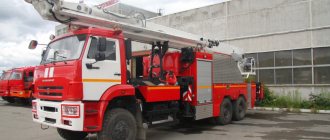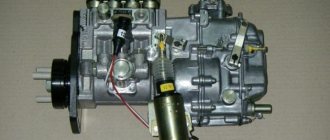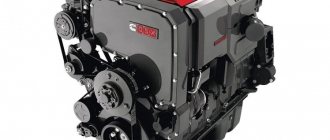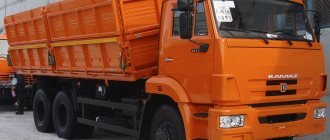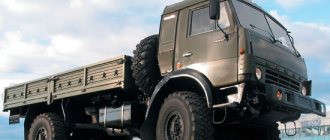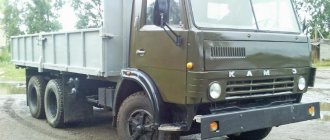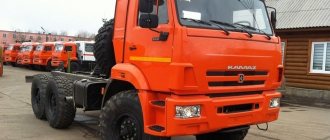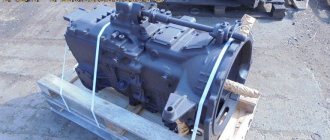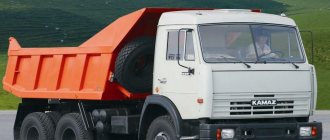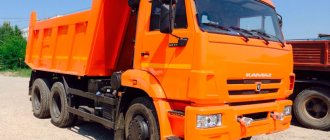Device
The KamAZ crankshaft design includes the following parts:
- Connecting rod and main journals, which are interconnected. Connecting rod type journals have a smaller diameter. They are used as support.
- Counterweight. Helps balance the weight of the piston and connecting rods.
- Knee. Equipped with one crankpin, which is located between two brushes.
- Sliding bearings. They allow the connecting rods in the journals and in the crankshaft mechanism to rotate.
- The shank on which the flywheel is mounted to take power from the crankshaft.
- Flange and brushes.
The difference between KamAZ crankshafts of different models lies in the material used (cast iron or steel), as well as in the number of connecting rod journals.
Crankshaft 740 Euro-0, new, old model
Description
The crankshaft receives the forces from the pistons transmitted by the connecting rods and converts them into torque.
In addition, the crankshaft ensures the movement of the pistons during auxiliary strokes and engine starting, and also drives auxiliary mechanisms that ensure engine performance. The crankshaft is made of high-quality steel, has five main and four connecting rod journals, hardened with high-frequency heat, interconnected by cheeks, which are mated with transition fillets.
In the crankshaft, two connecting rods are attached to the connecting rod journal, needed for the right and left banks of cylinders. Six counterweights are installed to balance inertial forces and reduce vibrations.
Marking and branding
All crankshafts of KAMAZ PJSC have the following markings:
— designation of the crankshaft on the side surface of the third counterweight, counting from the flange on the fan side. Marking is done in a protruding font when stamping a forging (for example, “740.50-10005020”). On some shaft models, part of the markings (framed symbols in the designations “740.30-10005020-01”, “740.65-10005020-“, “740.b2-10005020”, “740.70-10005020”) is performed by impact;
— shaft serial number — on the machined surface of the third counterweight;
- date of manufacture of the forging - on the side surface of the 4th counterweight: the first two digits are the year, the third character from the list {1-9, O, N, D} is the serial number of the month (for example, 09Н - November 2009, 085 - May 2008 G.);
— trademark “KAMAZ” on the side surface of the 5th counterweight;
— “R65” — the value of the crank radius on the side surface of the 6th counterweight (only for crankshafts 740.50-1005020, 740.70-1005020, 740.62-1005020, 740.65-1005020);
— quality control mark on the treated surface of the 8th counterweight.
Installation of crankshaft with flywheel 740.1000450
| 1 | 1/59707/21 | Bolt M10 x 1.25 x 25 | 4 things. |
| 2 | 870851 | Lock washer 10 | 9 pcs. |
| 3 | 740.1005544 | Washer | 1 PC. |
| 4 | 740.1005106 | Bolt | 5 pieces. |
| 5 | 740.1005534 | Power take-off half | 1 PC. |
| 6 | 740.1005008 | Crankshaft assembly | 1 PC. |
| 7 | 740.100517 | Upper bearing shell | 5 pieces. |
| 8 | 740.1005184 | Upper bearing half ring | 2 pcs. |
| 9 | 740.1005127-10 | Bolt | 8 pcs. |
| 10 | 740.1005115-10 | Flywheel assembly | 1 PC. |
| 11 | 864709 | Ball bearing | 1 PC. |
| 12 | 740.1005183 | Lower bearing half ring | 2 pcs. |
| 13 | 740.1005171 | Lower bearing shell | 5 pieces. |
Why should you buy from us?
| We provide a clear guarantee of the quality of spare parts from reliable manufacturers |
| Large selection, competitive prices, discount system |
| Prompt delivery throughout Russia |
Make an order
| Call the phone number indicated in the header of the site. Information will be required: car model, year of manufacture, unit model, Euro class. |
| Details can be sent using the “Request an offer” button or by email |
| The sale is formalized by signing a purchase and sale agreement. Prepayment is required. |
| Delivery is carried out by transport carriers. At the delivery point you will be able to inspect and check the goods |
Guarantee
| Manufacturer's warranty is provided. The warranty remains valid in the absence of mechanical damage and signs of abnormal use. The installation of units and spare parts must be carried out by a specialized service. |
Returns and exchanges
| We provide the opportunity to return/exchange spare parts under the following conditions: — No more than 14 days have passed from the date of receipt; — The integrity of the packaging is not compromised; — The part must be in its original presentation and must have no traces of installation or use; — There are no returns for custom driveshafts or non-standard units. |
Dimensions and other characteristics
Parameters and technical indicators of the KamAZ crankshaft:
- crank radius - 4.6 cm;
- radius of extreme counterweights - 8.5 cm;
- radius of middle counterweights - 8.2 cm;
- diameter of the molar neck - 6.4 cm;
- connecting rod journal diameter - 5.8 cm;
- crankshaft flange diameter - 12.2 cm;
- connecting rod journal width - 3.6 cm;
- width of the molar neck - 4 cm;
- number of counterweights - 4;
- protective chamfers - yes;
- piston stroke - 13 cm;
- diameter of cylindrical elements - 12 cm;
- body material - cast iron or steel alloy;
- maximum torque - 2200 rpm;
- repair dimensions - 0.5*0.2 m;
- permissible imbalance - no more than 35 g/cm;
- the entire mechanism including counterweights weighs 76 kg.
Weight mass Crankshaft KAMAZ
Crankshaft (repair EURO) 1 root/2 connecting rod (ON ORDER) 740.13-1005008 (pcs) weight weight = 70 kg
Crankshaft (repair) 0.25 root / 0 connecting rod (ON ORDER) 740-1005008 (pcs) weight mass = 72 kg
Crankshaft (repair) 0.25 root / 0.25 connecting rod (ON ORDER) 740-1005008 (pcs) weight mass = 72 kg
Crankshaft (repair) 1 root/1 connecting rod (ON ORDER) 740-1005008 (pcs) weight mass = 76.8 kg
Crankshaft (repair) 2 root/0 connecting rod (ON ORDER) 740-1005008 (pcs) weight mass = 76.8 kg
Crankshaft (repair) 2 root/2 connecting rod (ON ORDER) 740-1005008 (pcs) weight mass = 75 kg
Crankshaft of 1-cylinder compressor 53205-3509110 (pcs) weight mass = 1.585 kg
Crankshaft of 2-cylinder compressor 5320-3509110 (pcs) weight = 1.3 kg
Crankshaft 6ISBe, 6ISDe, QSB 4934862 / 3974635 / 3974538 / 5301009 / 3968164 .. (pcs) weight weight = 61.8 kg
Crankshaft 6ISBe, 6ISDe, QSB / DCEC 4934862 / 3974635 / 3974538 / 5301009 / 3968164 .. (pcs) weight weight = 85 kg
Crankshaft assembly (repair) 0.25 ISF3.8 5261376(+0.25) / 4938752 / 4896766 / 5261375 (pcs) weight mass = 41.76 kg
Crankshaft assembly ISF2.8 5264231 / 5264230 / 5282791 / 5340179 (pcs) weight weight = 30 kg
Euro crankshaft (root P0 connecting rod P1) for engine 740.11; 740.13 OJSC Kamaz 740.13-1005008-02 (pcs) weight mass = 77 kg
Euro crankshaft (root P0 connecting rod P1) for engine 740; 7403 OJSC Kamaz 740.13-1005008-22 (pcs) weight mass = 77 kg
Euro crankshaft (root P1 connecting rod P0) for engine 740; 7403 OJSC Kamaz 740.13-1005008-23 (pcs) weight mass = 77 kg
Crankshaft Euro / KamAZ OJSC 740.13-1005008 (pcs) weight mass = 70 kg
Crankshaft Euro-2 (root P0 / connecting rod P1) / KamAZ OJSC 740.30-1005008-02 (pcs) weight mass = 77 kg
Crankshaft Euro-2 (root P1 / connecting rod P0) / KamAZ OJSC 740.30-1005008-03 (pcs) weight mass = 77 kg
Crankshaft Euro-2 (for engines 240 hp) / KamAZ OJSC 740.13-1005008-10 (pcs) weight weight = 74.7 kg
Crankshaft Euro-2 (for engines 240, 260 hp) / KamAZ OJSC 740.30-1005008 (pcs) weight mass = 74.7 kg
Euro-2 crankshaft (for engines 320, 360 hp) 740.55 / KamAZ OJSC 740.55-1005008 (pcs) weight weight = 76 kg
Crankshaft Euro-3 (root P0 / connecting rod P1) / KamAZ OJSC 740.62-1005008-02 (pcs) weight mass = 92 kg
Crankshaft Euro-3 (root P1 / connecting rod P0) / KamAZ OJSC 740.62-1005008-03 (pcs) weight mass = 76 kg
Crankshaft Euro-3 (root P1 / connecting rod P1) / KamAZ OJSC 740.62-1005008-01 (pcs) weight mass = 76 kg
Euro-3 crankshaft (for engines 280, 320 hp) / KamAZ OJSC 740.62-1005008 (pcs) weight weight = 76 kg
Crankshaft Euro-4 (nitrided) / KamAZ OJSC 740.71-1005008 (pcs) weight mass = 77 kg
Euro-4 crankshaft (for an engine with Common Rail) / KamAZ OJSC 820.70-1005008 (pcs) weight = 76 kg
Crankshaft for 5490 (AXOR) disassembled (with warranty) A4570300401 (pcs) weight = 70 kg
Crankshaft P0 / KamAZ OJSC 740.13-1005008-20 (pcs) weight mass = 76 kg
Repair work
Malfunctions of the KamAZ crankshaft and ways to eliminate them:
- Damage to the main or connecting rod journals, deformation of the seats. In this case, it is recommended to grind the parts to the repair size, apply a coating using electric arc surfacing, and weld the electrical contact strip.
- The thread on the oil scraper ring is worn. It is necessary to deepen the thread using a cutter and grind the neck.
- Defective key, seat and ball bearing. In this case, it is necessary to perform milling to match the increased parameters of the keys, make surfacing followed by milling the key, and press in the bushings.
- Damage to the holes for the flywheel mounting pins. It is necessary to unroll the parts to the repair size.
How to remove a bearing
To remove a bearing from the crankshaft, you must:
- Remove all vehicle components that prevent access to the crankshaft.
- Place the power unit block on the stand that is used to repair the engine.
- Remove the flywheel. For comfortable operation, it is recommended to install a locking device on the flywheel crown. Before removal, the position of the mechanism relative to the motor block is noted, and a marking is made as to the sequence in which the mounting bolts were installed.
- Remove the oil pan and oil pump.
- Remove the bearing caps and the connecting rods themselves. They need to be removed along with the pistons.
- Remove the crankshaft.
- Clean seating surfaces.
- Remove the bearing.
How to balance
Procedure for balancing:
- Place the machine in a horizontal position.
- Install the crankshaft on the machine. If there is an imbalance and the shaft begins to rotate around the corner, such an imbalance must be eliminated.
- Using small magnets, determine the exact weight of the metal that needs to be cut. To do this, magnets must be attached to the light side of the flywheel. They are hooked until the crankshaft lies motionless, without overweight. The weight of the magnets is the weight of the metal that must be cut off to balance.
- Remove any chips from the flywheel.
- Trim off excess metal by drilling small holes in the flywheel housing.
- Return the crankshaft back to the vehicle.
KAMAZ 740 crankshaft, Characteristics of the KAMAZ 740 crankshaft and repair dimensions.
The KAMAZ 740 joint shaft is manufactured from high-carbon steel using the hot stamping method and is also treated with additional nitriding or hardening with high-frequency jets (HFC). Connecting rods and necks are subject to hardening. The KAMAZ 740 crankshaft has crankpins and five main supports that bind the cheeks. The connecting rod journals of the shaft are made in such a way that they move in the middle of the empty box and are closed with plugs. The empty tanks are protected by additional oil purification using sub-central forces.
To ensure equalization of the central forces on the so-called scarpet (the front end of the joint) and the shank (the rear end of the joint), counters are installed on the cheeks of the joint entirely with the shaft, and they are pressed onto the nose at the time of folding and closing Used for additional segment keys.
At the front end of the crankshaft there is a gear that drives the oil pump, it is wired, and on the shank (rear end) there is a gear with a separate oil deflector. At the front part (nose) of the rotary shaft, the vikon openings are opened for installing the coupling. At the front part of the shank there are two openings for pressing in the flywheel fixing pins, an axial opening for the support bearing of the transmission primary shaft and threaded openings for the flywheel mounting bolts.
The possibility of axial displacement is turned off by fixing the shaft behind several lightweight steel-aluminum rings, which are inserted into the windings of the engine crankcase and the main support cover. On the rear part (on the shank), the component shaft is reinforced with an oil seal and pressed into the flywheel housing.
The role of the connecting rod and main bearings is determined by the liners that are installed so-called. Inserts, both main and connecting rods, are made from steel strips coated with a lead bronze ball. On the original liners, the upper and lower parts are not interchangeable, since oil is supplied to the upper openings and the grooves are separated. And the axle halves of the connecting rod bearings are interchangeable.
During the operation of the engine, the pins of the KAMAZ crankshaft are worn out, and it can be ground several times, and the bearings are available in seven repair sizes.
Another feature of the KAMAZ crankshaft is that the block and connecting rods can be milled to size.
Repair dimensions of the crankshaft journals and bearings under the liners
| Connecting rod bearing | Core bearing | ||||
| diameter, mm | labeling of the insert | diameter, mm | Marking of upper (lower) liner | ||
| necks of the collapsible shaft | connecting rod | necks of the collapsible shaft | Lick the block | ||
| 79,50-0,013 | 85,0+0,01 | 740.1004058 P1 79.50—85.0 | 94,5-0,015 | 100,0+0,021 | 740.1005170 (740.1005171) Р1 94.50—100.0 |
| 79.00-0,013 | 85,0-0,01 | 740.1004058 Р2 79.00 | 94,0-0,015 | 100,0 -0,21 | 740.1005170 (740.1005171) Р2 94.00—100.0 |
| 80,00-0,013 | 85,5+0,01 | 740.1004058 RZ 80.00—85.00 | 95.O-0.015 | 100,5+0,021 | 740.1005170 (740.1005171) RZ 95.00—100.5 |
| 79,50-0,013 | 85,5+0,01 | 740.1004058 P4 79.50—85.5 | 94,50-0,015 | 100,5+0,021 | 740.1005170 (740.1005171) Р4 94.50—100.5 |
| 79,00-0,013 | 85,5+0,01 | 740.1004058 P5 79.00—85.0 | 94,0-0,015 | 100,5+0,021 | 740.1005170 (740.1005171) P5 94.00—100.5 |
| 78.5 Pro-0.013 | 85,0+0,01 | 740.1004058 P6 78.50—85.00 | 93,50-0,015 | 100,0+0,021 | 740.1005170 (740.1005171) Р6 93.50—100.0 |
| 78,00-0,013 | 85,0+0,01 | 740.1004058 P7 78.00—85.0 | 93.O-0.015 | 100,0+0,021 | 740.1005170 (740.1005171) Р7 93.00—100.0 |
Marks of the repair size and diameters of the crankshaft journals and bearings of the block or connecting rods are applied to the back side of the liner not far from the socket area.
The flywheel (Fig. 2) is necessary for the accumulation of kinetic energy during the working stroke and the wrapping of the shaft during additional strokes, as well as for removing the piston from dead spots and changing the unevenness of the shaft wrapping.
The flywheel is made of a special gray chavun. It is secured at the rear end of the crankshaft with 3 alloy steel bolts. Precise fixation of the flywheel on the crankshaft is achieved using two alignment pins pressed into the end of the crankshaft. A toothed end 1 is pressed onto the machined cylindrical surface of the flywheel to connect the starter shaft with the gear when starting the engine. A seal is installed at the rear end of the flywheel. To adjust the motor on the flywheel, there is a groove under the 2 flywheel lock and 12 openings for turning the crankshaft with a crowbar.
